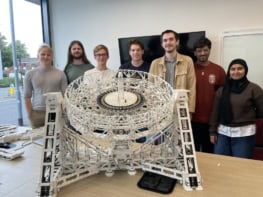Are you looking for a fun physics activity to do with the kids this weekend? The Institute of Physics’ Melissa Brobby has just the thing – a self-spinning water sprinkler made from a milk carton. In the above video, she shows you how to make a sprinkler and tells you about the physics that makes it spin.
The video is part of the Institute’s Do Try This at Home series, which aims to make it easy for parents and carers to get their children excited about physics. If sprinklers are not your cup of tea, how about a balloon rocket – as described below by the Institute’s Mikey Jarrell.
If I had to name a physics-related technique that is most like magic, I would have to say lidar. This involves firing laser pulses at an object or landscape of interest and using the reflected light to create a 3D map of the object or landscape topography. The seemingly magic bit is that lidar can often see through vegetation – revealing what lies on a forest floor, to a lidar system flying overhead. This has proven very useful for archaeologists, who have used lidar to make some spectacular finds.
Now, lidar has revealed the largest and oldest Mayan structure known to archaeologists. The huge rectangular elevated platform was built between 1000–800 BC in Mexico’s Tabasco state and was found by Takeshi Inomata of the University of Arizona and colleagues. The discovery is described in Nature, where the team also explains how it used radiocarbon dating to work out the age of the structure.
Das Perfekte Dinner is a reality TV programme like the UK’s Come Dine with Me, in which people take turns hosting a dinner party for each other throughout a week. Each dinner is scored by the other contestants on the evening that is served.
Physicists Peter Blum and Marc Wenskat at the University of Hamburg have analysed results from the German show and have concluded that a contestant’s chances of winning are boosted if they host their dinner later in the week.
In a preprint uploaded to arXiv, they say that their finding is an example of the “secretary problem” that arises when things are rated consecutively using the same criteria. Apparently, the application of those criteria change as each scoring occurs, skewing the results.



